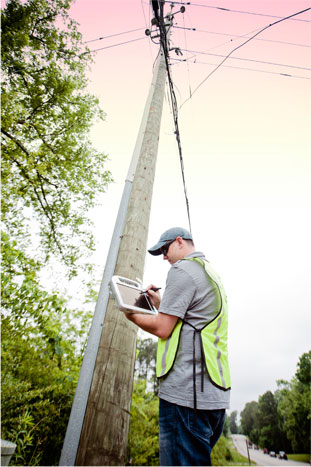Utility Pole Joint Use - How Does It Work?

What is Joint Use?
Like many businesses, utility companies generally own and operate the majority of their equipment and resources independently. The major exception involves the means of transmitting and delivering power and communications signals to their customer: the utility poles that carry aboveground wires.
There is a logical maximum number of utility poles that can exist along any given street, and the prospect of wires from several independent sets of poles weaving among one another poses numerous safety and repair hazards.
In the past few decades, cable television and Internet providers caused a giant increase in demand for utility pole space. It has long been common practice for multiple utility companies to jointly use the same set of poles, therefore the communications between these pole owners and attachers have also greatly increased, causing another set of problems.

How Does Joint Use Work?
Joint use of utility poles is handled in a few ways. A few areas use a policy of joint ownership, in which individual poles are broken down by percentage and owned by several utility companies. "Ownership parity" has been the common system of the past century, in which agreements set out the overall percentage owned by an electricity provider and an incumbent local exchange carrier (ILEC).
However, now other entities such as municipalities, city, state, county and private organizations such as hospitals and universities also own poles. The situation is only getting more complicated. Other utilities, such as competitive local exchange carriers (CLEC), cable television providers and other communications providers typically do not own many utility poles on their own and generally find themselves in the position of attacher or tenant, attaching lines to poles owned by another company.
Challenges of Joint Use
Communication among utility pole owners and tenants is vital for any joint use situation. When several utilities share the same poles, they must be able to coordinate their efforts in the event of necessary pole maintenance. When poles must be removed or replaced in the event of pole deterioration, accident damage or road widening, the removal and transfer of pole attachments must be conducted in an organized and sequential manner to assure the safety of the utility workers and a minimal disruption in service.
Utility pole inspection is an important part of regular utility maintenance and a basic component of infrastructure asset management. Though utility poles are treated to resist decay, several years of exposure to the elements will take their toll on the wood. The need for clear communication among joint use utility pole owners and attachers is vital when poles need to be inspected, either by Resistograph, Sound & Prod, Sound and Bore or another method.
The pole owner is responsible for the general coordination of the various attachers. If the inspection of the poles, which can involve anything from a simple visual analysis to excavation around the base of the pole, reveals significant decay or other problems, the joint use utility pole owners must then coordinate the efforts of the attachers and tenants in order for the repair to take place, or for the application of remedial preventative treatments. The responsibilities of each party in a joint use agreement with regard to inspection are outlined in attachment agreements.
